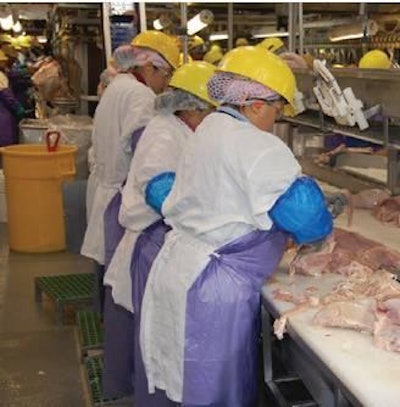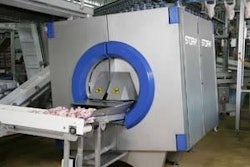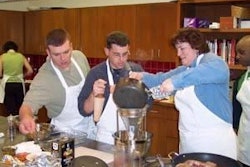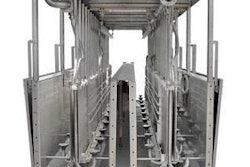
Two of the largest turkey companies in the U.S. share a significant achievement. Of the 2,015 facilities falling under the Occupational Safety and Health Administration's (OSHA) standard industry classification (SIC) of poultry slaughtering and processing, onlynine plants are recognized as Voluntary Protective Program (VPP) Star or Merit sites (see sidebar, OSHA VPP). All nine of these plants are Cargill Value Added Meats or Butterball LLC turkey processing facilities. In addition, Cargill Value Added Meats has two feed mills and one turkey hatchery that are VPP Star sites and and a feed mill that is a VPP Merit site.
Both Butterball and Cargill had strong safety programs before beginning participation in VPP, but both organizations saw going through the VPP process as a means of taking a step forward to enhance safety for their workers. Mike Klun, environmental, health and safety (EHS) manager, Cargill Value Added Meats, said, "For a safety person, VPP just makes sense. It is what we are supposed to be doing already. Our process has gotten better, and we have polished what we had before VPP." Richard Vaughn, distribution manager, member of the Star Site committee, Butterball LLC, Mt. Olive, North Carolina, said, "Mt. Olive already had a good safety program, but it had reached a plateau and it was increasingly difficult to find ways to improve. We saw VPP as a way to kick it up a notch and improve our performance."
Charles Phillips, complex safety, security, emergency services manager, Butterball LLC, Mt. Olive complex, said, "The poultry industry is catching up on safety industry-wide with other industries, and in some cases the poultry industry is taking the lead. We need to try to have the best possible environment for worker safety and the best environment for food safety. As plants have improved, it becomes more challenging to improve safety performance." Phillips has seen first hand at his own complex how participating in VPP can help an operation continue to improve, even after what he called the "low hanging fruit" has already been picked.
Management commitment and employee involvement
VPP has several elements, according to Brian Rodgers, corporate director, safety and risk management, Butterball LLC. Worksite analysis, hazard prevention and control and employee training are all elements of VPP. But, Rodgers said, "Management commitment and employee involvement are the biggest reasons for success."
Vaughan said: "The biggest and best change in my 20 plus years in the poultry industry is getting the hourly employees involved in safety. You can preach it from up top and mandate it, but it doesn't matter unless it makes it to the plant floor."
One way to increase employee involvement is to encourage employees to come forward with suggestions or ideas for changes. Another way to involve employees is to make them part of the process at each and every step. The Star site team at the Mt. Olive plant has a lot of the authority that a safety steering team might normally have and over half of the team members are hourly associates. Each department is represented on the Star site team.
Jennie Myers is a member of Mt Olive's Star site team and she is an associate working on the line in the plant. She explained how she has seen employee involvement in the safety process grow and how it has yielded positive results. "Once you can get associates involved and they understand that you care, then you can get them to cooperate," Myers said. "If we all work together we can make it a better and safer working place for everyone. Anyone getting injured affects everyone at the workplace."
Myers said that at the Star site meetings they go over accidents and incidents and then discuss solutions and other things that people are seeing on the plant floor. The team also investigates near misses and employee first aide trips as well.
Continuous improvement
Kevin Meland is the EHS manager for Cargill's Timberville, Virginia, further processing facility and he is also VPP coordinator for all of Cargill Value Added Meats. He has helped to spearhead Cargill's VPP efforts and was instrumental in getting Cargill's Harrisonburg, Virginia, feed mill to Star site status, the first poultry facility to attain this honor. "To get continuous improvement you really need to work on employee involvement," Meland said. "It can't be the EHS manager doing the work and directing the program, it needs to come from the employees. If employees are engaged and contributing, the small incremental changes made will result in reduced incident rates." Employee involvement is what creates a safety culture where it isn't just the EHS manager or plant manager who tries to think up changes to improve safety, according to Meland. Instead, the cumulative effect of all of the ideas and changes in employee behavior will yield a work environment that keeps getting safer and safer.
Employee involvement doesn't just improve safety. Meland said that this type of employee engagement is also what improves product quality, production efficiency and will ultimately improve absenteeism and employee turnover. He cited the extremely low turnover rate at the Timberville facility, 15% per year, as an example of how an engaged work force can benefit employees and the company in many ways.
Butterball has also seen the benefits of an engaged work force. The total recordable incident rate (TRIR) at the company's processing plants is nearly 50% below the poultry industry average. Remarkably, some of Butterball's slaughter facilities have TRIRs that are more than 70% below the industry average.
VPP is worth it
Audits and self evaluations are important parts of the VPP process. It requires management commitment, employee involvement and a real solid safety culture for a facility to reach Star site status. It is hard work, but managers at both Cargill and Butterball agree that it is worth it.
Andy Southerly, vice-president operations, Cargill Value Added Meats, said that VPP ties in well with other Cargill programs. Cargill's Strategic Intent 2015 program established a goal for the company to be a partner of choice with its customers, community and employees. "Being a VPP site fits with the Strategic Intent initiative," Southerly said.
"We saw VPP as a step in the right direction because it is a partnership with OSHA. VPP also allows Cargill to partner with other companies in the program and lets Cargill establish a leadership position in the community regarding safety and this fits where Cargill wants its locations to be, leaders in the community," Southerly said. Cargill Value Added Meats has set the goal of having all of its facilities attain Star site status within the next three years.
Managers at both Butterball and Cargill encouraged other facilities both inside and outside the poultry industry to look into becoming part of VPP.
Part of these two companies' commitment to the program is to help other facilities reach Merit and Star status. Butterball and Cargill are safety stars.


















